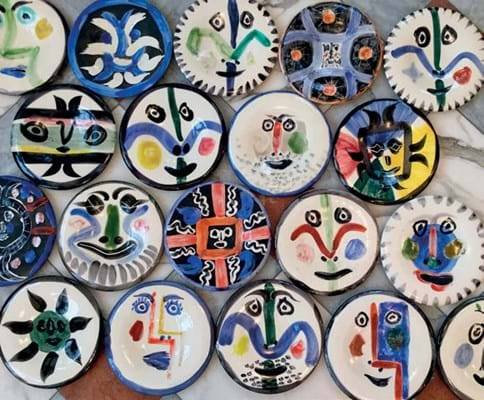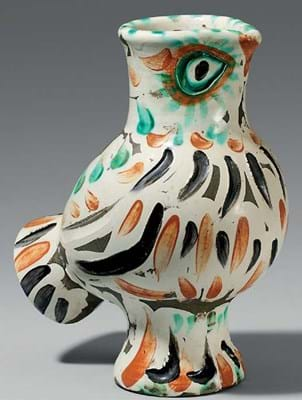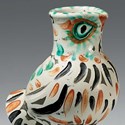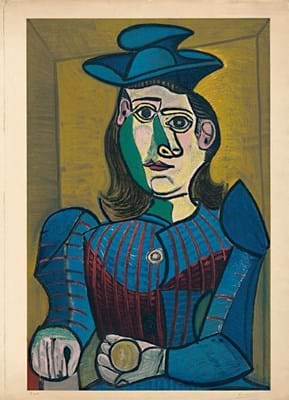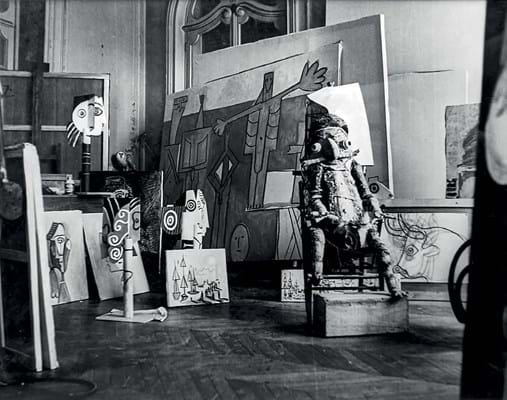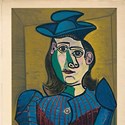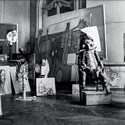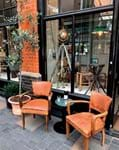A photograph by Picasso’s friend André Villers captures the artist’s mid-century Cannes studio in its rather chaotic glory. The studio was part of Villa la Californie, a huge 1920 mansion on the coast which Picasso occupied from 1955-61.
Though by that time his fame was already well-established, he continued to create avidly, producing entire editions of ceramics.
Offered for €2000, the photo (below) – along with many examples of Picasso’s prints, drawings and ceramics – features in Aetelier Picasso, an exhibition at Mayfair’s Bastian Gallery.
The southern French studio will be recreated as an installation and selling show taking place from September 3-October 31.
In total, 70 works by the artist are on show, many produced before or after his residence in the villa.
Man of many faces
Among the highlights is a complete set of the 20 Visage plates, which Picasso created in 1963. Each round dish bears a similar, simple smiling-face motif. Not conceived as a specific series, the individual pieces come from editions of different sizes, and are gathered here to tempt collectors of Picasso ceramics with what is probably a one-off set.
A small Wood Owl sculpture is available for €40,000 (above), along with other ceramic sculptures and dishes, usually decorated with faces and figures.
A selection of two-dimensional works includes lithographic posters and an etching from Picasso’s Vollard Suite, which features the minotaur.
These pieces are joined by examples of the sort of tribal art that Picasso kept close at hand for inspiration as well as furniture and ornamentation.
However, since the artist’s acquisitive tendencies could easily be described as hoarding, the gallery will stop short of a blow-by-blow recreation.
“It’s a difficult line to tread,” says Bastian’s sales director Chris Craig. “The walls will be full, but we are going to avoid having stuff strewn across the floor.”
Even without the full-clutter experience, a studio installation show can help contextualise individual works for viewers and express the artist’s point of view.
The format has popped up in other places recently, such as Waddington Custot’s recreation of Peter Blake’s studio at Frieze Masters in 2017 and Messums Wiltshire’s exhibition of Elisabeth Frink’s studio show on now (ATG No 2453). “There has been a trend for this sort of show, and it’s really important for a gallery to fulfil both the academic and entertainment criteria,” Craig says.
“The context you can give really enhances the understanding of objects, especially when you have them in large volume. It can reflect how collectors might show them off in their own home.”
He points out that many of the ceramics in the show were originally made as practical pieces and often used as dinner services, until the vogue for collecting Picasso ceramics took off (one of its largest boosts famously coming from the sale of the Madoura Collection at Christie’s South Kensington in 2012).
Placing these works in a spare, white gallery takes them away not only from their practical purpose but also from the artist’s original intentions.
“Picasso was adamant that his works needed to be seen in context. He thought people needed to know where he was when he created them,” Craig adds. “There are some artists that would deny that their works need this sort of context, but his works are so self-referential and so autobiographical.”
Major event
Originally the show was planned for the summer, the idea being that visitors could come in from the heat and picture themselves in the south of France.
Due to lockdown it was pushed back and bulked up so that it is now set to be a major event for the gallery, kicking off the traditional return to business in September.
While Craig admits that the future of the London market is still uncertain, he is hopeful that the autumn will bring back collectors and buyers, including international visitors who put off travelling in spring and summer as a result of Covid-19. And, he points out, it’s crucial to stage something – otherwise why would anyone come?
Bastian was founded in Germany in 1989 and specialises in Modern and Contemporary Art. The London gallery opened in February 2019 and has so far held exhibitions on artists including Andy Warhol and Cy Twombly.


